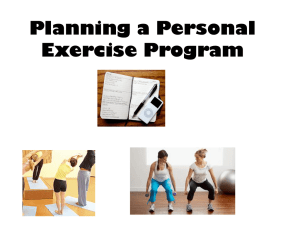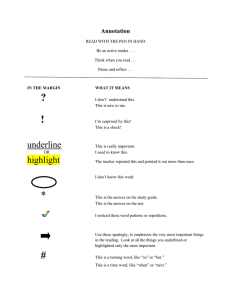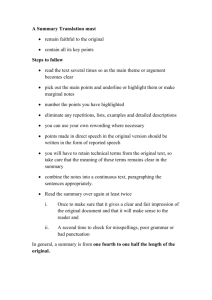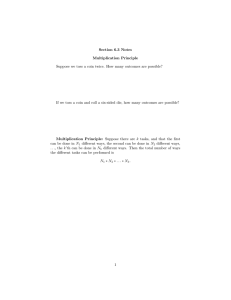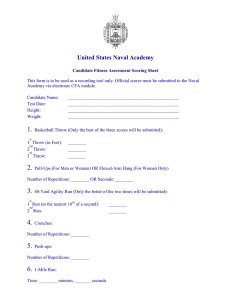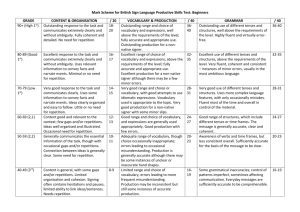PERFECT PRACTICE MAKES PERFECT
advertisement
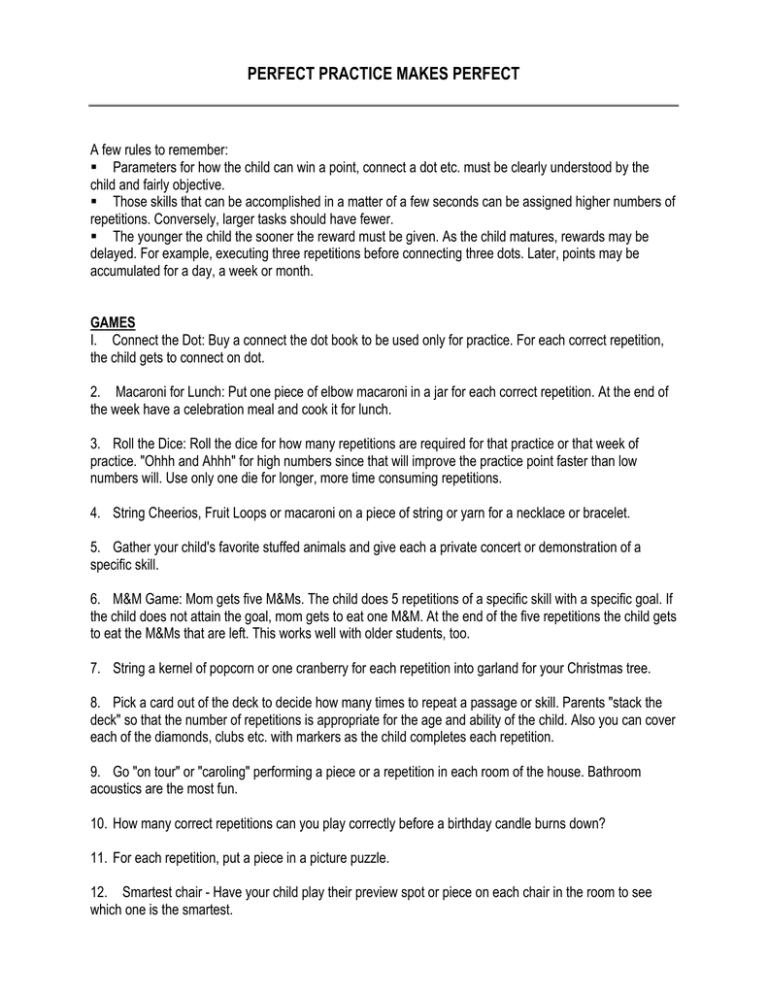
PERFECT PRACTICE MAKES PERFECT A few rules to remember: Parameters for how the child can win a point, connect a dot etc. must be clearly understood by the child and fairly objective. Those skills that can be accomplished in a matter of a few seconds can be assigned higher numbers of repetitions. Conversely, larger tasks should have fewer. The younger the child the sooner the reward must be given. As the child matures, rewards may be delayed. For example, executing three repetitions before connecting three dots. Later, points may be accumulated for a day, a week or month. GAMES I. Connect the Dot: Buy a connect the dot book to be used only for practice. For each correct repetition, the child gets to connect on dot. 2. Macaroni for Lunch: Put one piece of elbow macaroni in a jar for each correct repetition. At the end of the week have a celebration meal and cook it for lunch. 3. Roll the Dice: Roll the dice for how many repetitions are required for that practice or that week of practice. "Ohhh and Ahhh" for high numbers since that will improve the practice point faster than low numbers will. Use only one die for longer, more time consuming repetitions. 4. String Cheerios, Fruit Loops or macaroni on a piece of string or yarn for a necklace or bracelet. 5. Gather your child's favorite stuffed animals and give each a private concert or demonstration of a specific skill. 6. M&M Game: Mom gets five M&Ms. The child does 5 repetitions of a specific skill with a specific goal. If the child does not attain the goal, mom gets to eat one M&M. At the end of the five repetitions the child gets to eat the M&Ms that are left. This works well with older students, too. 7. String a kernel of popcorn or one cranberry for each repetition into garland for your Christmas tree. 8. Pick a card out of the deck to decide how many times to repeat a passage or skill. Parents "stack the deck" so that the number of repetitions is appropriate for the age and ability of the child. Also you can cover each of the diamonds, clubs etc. with markers as the child completes each repetition. 9. Go "on tour" or "caroling" performing a piece or a repetition in each room of the house. Bathroom acoustics are the most fun. 10. How many correct repetitions can you play correctly before a birthday candle burns down? 11. For each repetition, put a piece in a picture puzzle. 12. Smartest chair - Have your child play their preview spot or piece on each chair in the room to see which one is the smartest. 13. How many correct repetitions can you play correctly before a birthday candle burns down? 14. For each repetition, put a piece in a picture puzzle 15. Graph your Progress: Decide on a specific goal and how many attempts will be made for each day. Using a piece of graph paper, start in the lower left hand corner. After each performance of the objective, the student marks a dot charting successful or unsuccessful attempts. Example: 16. Hang the Clothes Pin: Hang a clothespin on the child's shirt for each successful repetition. See how many are hanging at the end of the practice. Keep score for each day. 17. Read a Page: Decide on a story book that will be read only as a result of practice. For each correct repetition, one page is read to or by the student. 18. Chip Game: The parent and child each receive 5 chips.* The task is defined in objective and measurable terms by the child. Example: Playing one note, measure or phrase with a straight wrist. If the child is successful in completing the task, he or she receives one of the parent's chips. If the child is unsuccessful, the parent takes a chip from the child's stock. It is most valuable when the child is the judge of who receives the chip. If the child and parent disagree about who gets the point, the child must do the task again. 19. Happy Faces: A series of circles can be drawn on a blank sheet of paper. The child then plays a piece or designated passage. When the child is finished, the parent and child choose the face that bests describes their success. 20. Silly Repetitions: After the child has successfully completed the task one or two times, add some fun to the remaining repetitions by asking the child to play with their eyes closed, looking at the ceiling, standing on one leg, looking at you, etc. *Buttons, pennies, M&M's, peanuts, etc. may be substituted for chips.
